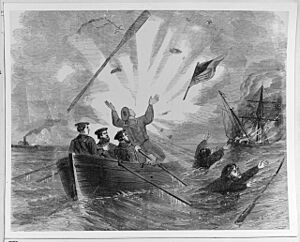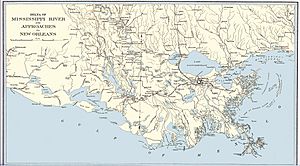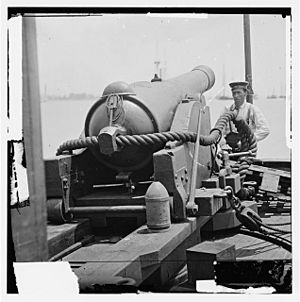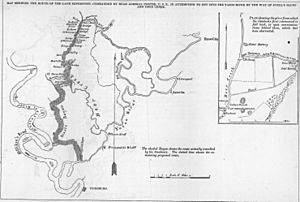CSS Ivy facts for kids
class="infobox " style="float: right; clear: right; width: 315px; border-spacing: 2px; text-align: left; font-size: 90%;"
| colspan="2" style="text-align: center; font-size: 90%; line-height: 1.5em;" |
|}
The CSS Ivy was a special kind of ship called a sidewheel steamer. It was bought by the Confederate States Navy during the American Civil War. This ship was chosen to be part of the "Mosquito Fleet."
The Mosquito Fleet was a group of riverboats. These boats were turned into gunboats. They were used to protect the Mississippi River near New Orleans. The Ivy was a strong ship. It had a powerful 32-pounder rifle gun.
CSS Ivyand USS Niagara.
The Ivy fought in important battles. It was part of the Confederate win at the Battle of the Head of Passes. It also fought in the defeat at the Battle of Island Number Ten. Later, the Ivy got stuck in the Yazoo River. It was destroyed in May 1863. This was done to stop the Union forces from capturing it.
Contents
| History | |
|---|---|
| Name | Ivy |
| Namesake | V.H. Ivy |
| Owner | Confederate States Navy |
| Builder | Burtis |
| Launched | 1845 |
| Commissioned | May 16, 1861 |
| Fate | Destroyed to prevent capture at Liverpool Landing, Yazoo River, May 1863 |
| General characteristics | |
| Tons burthen | 447 tons |
| Length | 191 ft (58 m) |
| Beam | 28 ft (8.5 m) |
| Draft | 9 ft (2.7 m) |
| Propulsion | Side paddle wheels, one vertical condensing beam engine; cylinders, 44” diameter, 11’ stroke |
| Speed | 12 knots (22 km/h; 14 mph) |
| Complement | 60 officers and men |
| Armament | 1 8”-smoothbore, 1 32-pounder rifle |
- Protecting the Mississippi River
- The Battle of the Head of Passes
- The Battle of Island Number 10
- Why the Ivy Was Destroyed
What Was the CSS Ivy Like?
The Ivy was 191 feet (58.2 m) long. It was 28 feet (8.5 m) wide. Its draft (how deep it sat in the water) was 9 feet (2.7 m). The ship had two large paddle wheels on its sides. These wheels made the ship move.
A powerful engine made the paddle wheels turn. This engine helped the Ivy go very fast. It could reach a top speed of 12 knots (22 km/h; 14 mph). The ship had a crew of 60 officers and men.
Ivy's Powerful Guns
When the Ivy was a privateer (a privately owned ship allowed to attack enemy ships), it had two brass 24-pounder guns. These were called smoothbore howitzers. Later, as a riverboat, its weapons were made stronger.
It got an eight-inch smoothbore gun at the back. It also had a 32-pounder rifled gun at the front. This front gun was very special. It was a regular 32-pounder gun that had been improved. Its barrel was "rifled," meaning it had grooves inside. This made the cannonball spin. Spinning made the shot go much farther and more accurately.
Metal bands were added to the gun. This made it stronger. It could fire a heavy 100-pound (6.4-inch) bullet. This gun was like a Parrott rifle. It was the strongest long-range weapon in the Mosquito Fleet.
Ivy's Early Days as a Privateer
Before it was the CSS Ivy, the ship had other names. It was known as Roger Williams and El-Paraguay. The CSS Ivy started its war service as a privateer. It was called V.H. Ivy.
A privateer was a private ship. It was given permission by the government to attack enemy merchant ships. This permission was called a "letter of marque and reprisal." The Ivy was very good at this. It captured four ships from the North.
One of the captured ships was the Enoch Train. This ship was bought by private groups. It was rebuilt into an ironclad ram called the Manassas. The Manassas was later taken over by Commodore Hollins. It became the CSS Manassas.
The Mosquito Fleet's Role
Protecting the Mississippi River
The Union Navy started a blockade at the mouth of the Mississippi River. This happened on May 27, 1861. The USS Brooklyn took its position there. This made the Confederate forces in New Orleans work harder to defend the river.
Commodore Hollins took charge of the river defense in July 1861. By August, he had created his Mosquito Fleet. This fleet was meant to defend the river around New Orleans. The fleet included CSS McRae, the main ship CSS Tuscarora, CSS Livingston, CSS Calhoun, CSS Jackson, and the Ivy. The Ivy was the fastest ship. So, it was used for scouting and had extra firepower.
The Battle of the Head of Passes
In September 1861, the Ivy started patrolling the Mississippi River. It was south of Forts Jackson and St. Phillip. On September 19, it met the USS Water Witch. The Water Witch was looking for a good spot for the Union fleet. The Union wanted to set up a base at the Head of Passes.
On October 5, the Ivy reported that three Union ships were at the Head of Passes. The Ivy fired its bow gun at them. Lieutenant Fry, the Ivy's captain, went back to the forts. He warned Commodore Hollins about the Union plans. Hollins decided to attack with the whole Mosquito Fleet. This attack led to the Battle of the Head of Passes. It was a Confederate victory. The Union fleet was forced to leave.
The Battle of Island Number 10
After this win, the Confederates thought the biggest threat was the Union's Mississippi River Squadron. This fleet was at the north end of the Mississippi. Battles like the Battle of Fort Henry, the Battle of Fort Donelson, and the Battle of Shiloh showed this was true.
So, the Mosquito Fleet, including the Ivy, was sent north. They took part in the Battle of Island Number Ten. This battle was a defeat for the Confederates. The Mosquito Fleet could not beat the USS Pittsburgh and Carondelet. These Union ships got past the Confederate defenses. The Mosquito Fleet had to retreat.
Why the Ivy Was Destroyed
After the Battle of Forts Jackson and St. Philip, New Orleans fell to the Union. Commander McBlair of the Confederate Navy ordered all remaining Confederate ships on the Mississippi to go to Yazoo City, Mississippi. This city was on the Yazoo River. He thought it was the only safe place left for the Confederate Navy.
But this refuge did not stay safe for long. In May 1863, Rear Admiral David Dixon Porter sent a Union fleet. This fleet was led by Lieutenant-commander Walker. Their mission was to destroy Confederate ships on the Yazoo River.
The Union force included USS Baron De Kalb, Forest Rose, Linden, Signal, and Petrel. The Forest Rose acted as a minesweeper. This means it cleared mines from the water. The Union fleet moved up the Yazoo River from May 24 to May 31.
The Confederate forces feared their ships would be captured. So, they destroyed the CSS Ivy. They also destroyed the Star of the West and two transport ships, Arcadia and Magenta. This was done to prevent the Union from taking them.





